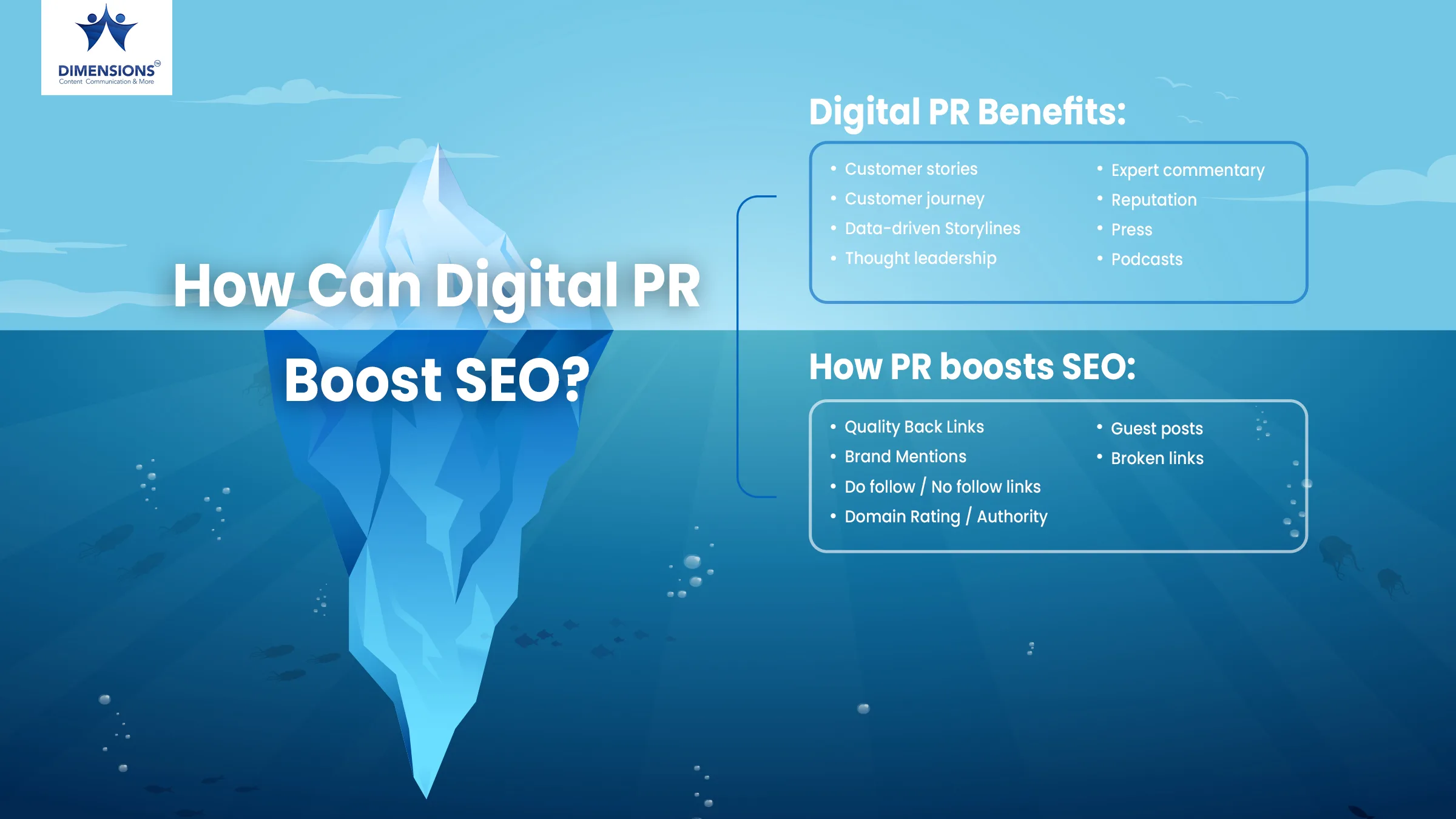How PR and SEO can Join Hands to Boost your Digital Marketing

In today’s dynamic digital era, brand visibility goes beyond mere presence. One needs to be actively sought after to create and cultivate a magnetic pull that draws the attention of the audience. Businesses are recognising the significant impact of the strategic intersection of SEO and PR.
Both the tools traditionally operate in separate silos. PR focuses on media coverage and reputation management while SEO focuses on elevating search rankings. However, with continuously evolving behaviour of online users. The boundaries between these two critical functions have blurred out. The true payoff in merging SEO and PR is a surge in brand searches. It ultimately strengthens the organic search footprint by growing the volume of branded searches, builds trust and a genuine demand. SEO and PR can unite to elevate branded search activity fosters an enduring growth, and outline methods for seamlessly integrating these two powerful disciplines for optimised digital public relations.
An Insight into PR and Digital PR
The traditional PR historically focuses on securing media placements with conventional channels like newspapers, magazines, radio, and television through journalist networking. The primary goal for a traditional publicist was to leverage contacts for client promotion, quotes, or crisis management.
In contemporary practices, traditional PR has successfully transitioned to integrate Digital PR leading to a broader readership and viewership in online content. Digital PR focuses strategically enhancing a brands online footprint. It achieves this by engaging with digital media, partnering with influencers, and distributing high-quality, authoritative content. Digital PR tools for SEO professionals harnesses the power of online publications, blogs, and ultimately social media to significantly elevate brand awareness.
This involves:
- Securing media placements on prominent social media platforms
- Building connections with notable bloggers, digital journalists and influencers
- Acquiring crucial backlinks from relevant domains to stand strong in the search engine results.
- Creating meaningful engagements on social media.
SEO
Search Engine Optimisation (SEO) is the process of structuring and optimising website content to enable search engines to accurately interpret its relevance and comprehend its content. This process facilitates the delivery of highly relevant and valuable results to users based on their specific search queries.
The core objective of SEO is to achieve prominent placement on the first page of search engine results pages (SERPs) for keywords that resonate most strongly with the target demographic, consequently driving qualified organic traffic.
SEO stands as a cornerstone of digital marketing and is universally applicable, enhancing a site’s discoverability on major search engines like Google and Microsoft Bing. Its principles apply whether your platform is designed for e-commerce, service provision, or knowledge dissemination, directly contributing to increased web traffic and online visibility. Fundamentally, superior visibility in search results directly correlates with increased user discovery and engagement.
The ever-advancing evolution of technology directly impacts website architecture and the modalities through which users interact with search engines. A typical web search may now be initiated via voice, a click can be a mobile screen tap, and search engine outputs are increasingly being synthesised by artificial intelligence (AI).
Onsite and Offsite SEO
On-site SEO is the very soul of your website and encompasses all the optimization efforts made directly on website to ensure its content is search engine friendly. These are the threads you control, the adjustments you make to ensure your content is not just seen, but truly understood.
While the technical aspects form the bedrock of on-site SEO, its true essence lies in content creation driven by thorough keyword research. The critical task is to identify and strategically incorporate appropriate keywords that will attract your audience throughout your website’s content. This process of keyword research and deployment is often referred to as on-page SEO because it focuses on individual pages and posts.
While numerous elements contribute to overall SEO performance, the core strength lies in content creation driven by meticulous keyword research, ensuring selecting and integrating terms that resonate with your target audience throughout your site, a relevant and memorable domain name, a comprehensive keyword strategy encompassing title tags, meta descriptions, URLs, subheadings, and main content; the intelligent use of LSI keywords for semantic depth; a logical link structure for seamless navigation; image optimization; effective anchor text and internal linking; robust website performance and fast load speeds, etc.
Off-site SEO is the expansive chorus of your brand that emanate beyond your website’s borders. It involves all promotional activities for your brand and website content that occur outside the actual website. Its primary objective is to cultivate high-quality, unique backlinks.
While you have some influence over off-site SEO, it largely depends on external validation and the opinions of others. Links pointing to your website are paramount, but search engines also increasingly consider brand mentions, discussions, and recommendations that may not include a direct link.
Backlinking
A backlink is a link from another website that leads to your website. High-quality backlinks can significantly boost your search engine rankings. This in turn improves overall visibility of the website ultimately driving more traffic.
Because backlinking activities happen off your website, it’s considered off-page SEO, distinct from on-page SEO. They are powerful endorsements tools. Direct recommendations from another credible website suggests that your content is valuable and worth exploring for more information on a particular topic. One can integrate PR here with SEO using journalist outreach to build quality backlinks. These improves the overall performance of the website.
SEO backlinks are a powerful catalyst for website growth. It influences your online presence in numerous ways. To truly stand out and claim a coveted spot on the first page of search engine results pages, many small businesses engage in some form of SEO, their efforts often remain confined to on-page activities—primarily focusing on integrating targeted keywords within their website content to improve rankings and attract traffic. However, to truly compete and achieve prominent visibility one can use backlinks for understanding and leveraging the external validation that is absolutely crucial.
How to use PR to Improve SEO rankings?
PR link building is a form of specialised SEO backlink-building methodology. It forms a critical pillar of any robust digital PR strategy that masterfully blends the strengths of digital public relations and search engine optimization to dramatically boost a website’s online visibility and domain authority. It centres on crafting compelling stories, publishing it on high-authority websites, valuable mentions of the brand and crucial links pointing back to your own digital property.
How to Create PR Content that ranks in Search?
Search Engine Optimisation (SEO) and Public Relations (PR) are quiet intertwined. One thrives on technical algorithms and data, while the other is built on human relationships and compelling narratives. Yet, peel back the layers, both work towards a overarching goal which is to elevate brand’s visibility. Here’s how these two reinforce each other:
- Unified Goal: Building brand visibility PR is the unified goal, and to architect the discoverability,
- PR’s Backlinking: Generating high-quality backlinks for SEO backlinks help in a top-tier ranking signal for google.
- PR campaigns that drive organic traffic: PR-Driven content influences Google’s E-A-T framework google meticulously evaluates a site’s Expertise, Authority, and Trustworthiness (E-A-T) when determining search rankings.
- SEO’s Contribution: Strong SEO performance will ensures that the PR content you crafted remains discoverable long after the initial buzz fades away. SEO strategies like keyword optimisation and strategic internal linking will make sure your PR content ranks well on google.
By integrating Public Relations and Search Engine Optimisation, businesses can obtain a synergy that transforms their digital marketing efforts and make it much more fruitful. The collaboration of PR and SEO transcends traditional boundaries, creating a robust, holistic digital marketing strategy that not only reaches your audience but deeply resonates, cementing your brand’s leadership in the competitive online landscape.





